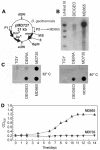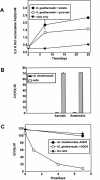Engineering Deinococcus geothermalis for bioremediation of high-temperature radioactive waste environments
- PMID: 12902245
- PMCID: PMC169113
- DOI: 10.1128/AEM.69.8.4575-4582.2003
Engineering Deinococcus geothermalis for bioremediation of high-temperature radioactive waste environments
Abstract
Deinococcus geothermalis is an extremely radiation-resistant thermophilic bacterium closely related to the mesophile Deinococcus radiodurans, which is being engineered for in situ bioremediation of radioactive wastes. We report that D. geothermalis is transformable with plasmids designed for D. radiodurans and have generated a Hg(II)-resistant D. geothermalis strain capable of reducing Hg(II) at elevated temperatures and in the presence of 50 Gy/h. Additionally, D. geothermalis is capable of reducing Fe(III)-nitrilotriacetic acid, U(VI), and Cr(VI). These characteristics support the prospective development of this thermophilic radiophile for bioremediation of radioactive mixed waste environments with temperatures as high as 55 degrees C.
Figures



Similar articles
-
Engineering Deinococcus radiodurans for metal remediation in radioactive mixed waste environments.Nat Biotechnol. 2000 Jan;18(1):85-90. doi: 10.1038/71986. Nat Biotechnol. 2000. PMID: 10625398
-
Co-expression of YieF and PhoN in Deinococcus radiodurans R1 improves uranium bioprecipitation by reducing chromium interference.Chemosphere. 2018 Nov;211:1156-1165. doi: 10.1016/j.chemosphere.2018.08.061. Epub 2018 Aug 14. Chemosphere. 2018. PMID: 30223331
-
Engineering of Deinococcus radiodurans R1 for bioprecipitation of uranium from dilute nuclear waste.Appl Environ Microbiol. 2006 Dec;72(12):7873-8. doi: 10.1128/AEM.01362-06. Epub 2006 Oct 20. Appl Environ Microbiol. 2006. PMID: 17056698 Free PMC article.
-
Engineering radiation-resistant bacteria for environmental biotechnology.Curr Opin Biotechnol. 2000 Jun;11(3):280-5. doi: 10.1016/s0958-1669(00)00096-3. Curr Opin Biotechnol. 2000. PMID: 10851141 Review.
-
Application Progress of Deinococcus radiodurans in Biological Treatment of Radioactive Uranium-Containing Wastewater.Indian J Microbiol. 2021 Dec;61(4):417-426. doi: 10.1007/s12088-021-00969-9. Epub 2021 Aug 12. Indian J Microbiol. 2021. PMID: 34744197 Free PMC article. Review.
Cited by
-
Transposition of Insertion Sequences was Triggered by Oxidative Stress in Radiation-Resistant Bacterium Deinococcus geothermalis.Microorganisms. 2019 Oct 12;7(10):446. doi: 10.3390/microorganisms7100446. Microorganisms. 2019. PMID: 31614796 Free PMC article.
-
Novel strategies and advancement in reducing heavy metals from the contaminated environment.Arch Microbiol. 2022 Jul 13;204(8):478. doi: 10.1007/s00203-022-03087-2. Arch Microbiol. 2022. PMID: 35831495 Review.
-
Toward Bioremediation of Methylmercury Using Silica Encapsulated Escherichia coli Harboring the mer Operon.PLoS One. 2016 Jan 13;11(1):e0147036. doi: 10.1371/journal.pone.0147036. eCollection 2016. PLoS One. 2016. PMID: 26761437 Free PMC article.
-
Bioremediation: a genuine technology to remediate radionuclides from the environment.Microb Biotechnol. 2013 Jul;6(4):349-60. doi: 10.1111/1751-7915.12059. Epub 2013 Apr 26. Microb Biotechnol. 2013. PMID: 23617701 Free PMC article. Review.
-
Physiology of resistant Deinococcus geothermalis bacterium aerobically cultivated in low-manganese medium.J Bacteriol. 2012 Mar;194(6):1552-61. doi: 10.1128/JB.06429-11. Epub 2012 Jan 6. J Bacteriol. 2012. PMID: 22228732 Free PMC article.
References
-
- Agnew, S. F., and R. A. Corbin. 1998. Analysis of SX farm leak histories: historical leak model. Los Alamos National Laboratory, Los Alamos, N.Mex.
-
- Arnone, M. I., L. Birolo, M. V. Cubellis, G. Nitti, G. Marino, and G. Sannia. 1992. Expression of a hyperthermophilic aspartate aminotransferase in Escherichia coli. Biochim. Biophys. Acta 1160:206-212. - PubMed
-
- Barrineau, P., P. Gilbert, W. J. Jackson, C. S. Jones, A. O. Summers, and S. Wisdom. 1985. The structure of the mer operon. Basic Life Sci. 30:707-718. - PubMed
-
- Battista, J. R. 1997. Against all odds: the survival strategies of Deinococcus radiodurans. Annu. Rev. Microbiol. 51:203-224. - PubMed
-
- Brim, H., S. C. McFarlan, J. K. Fredrickson, K. W. Minton, M. Zhai, L. P. Wackett, and M. J. Daly. 2000. Engineering Deinococcus radiodurans for metal remediation in radioactive mixed waste environments. Nat. Biotechnol. 18:85-90. - PubMed
Publication types
MeSH terms
Substances
LinkOut - more resources
Full Text Sources

